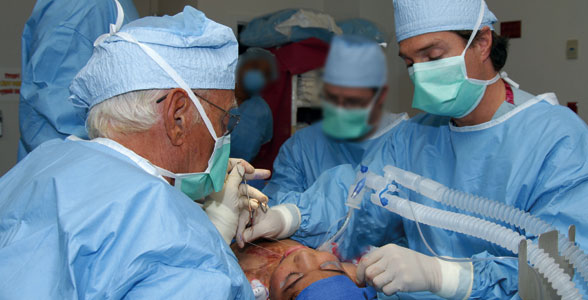By Sheila Champlin
Some men see things as they are and say ‘why?’ I dream of things that never were and say ‘why not?’ ” George Bernard Shaw wrote that famous quotation, which could be a personal motto for UT College of Medicine graduate Dr. A. Richard Grossman (’57).
It all started in 1958 at Cook County Hospital in Chicago. A catastrophic fire struck Our Lady of Angels parochial elementary school, killing 93 children and 4 nuns. Many of the victims were so badly burned, it was impossible to determine whether they were girls or boys. Young Dr. Grossman was the resident surgeon on duty in the emergency room.
That horrific experience had a profound and lasting impact. Not only did it cause him to question methods of burn care, it became the driving force behind his vision to create an innovative world-class comprehensive burn treatment center.
“I wanted to create a facility that would provide the best burn care available anywhere,” says Grossman, “but the goal was not just to ensure the survival of the patient. Our goal was to restore patients to as close to their pre-injury condition as possible—functionally, emotionally, and cosmetically.”
After relocating to Los Angeles, Grossman took a significant step toward achieving his vision. In 1969 he convinced Sherman Oaks Community Hospital, located in a suburb of Los Angeles, to devote two beds exclusively to burn care. By 1978 the burn center at Sherman Oaks had expanded into a freestanding 30-bed specialty unit.
A second Grossman Burn Center was opened at Western Medical Center in Santa Ana, California, in 1995. The 7-bed inpatient unit is an intensive care facility, equipped to handle the most severe burn cases, as well as to offer intermediate care for patients with less severe burns. Operating in tandem with the hospital, the center also provides outpatient burn care, surgical suites, hydrotherapy, and access to all the services and support of a large medical system.
Today the two Grossman centers rank among the largest and most comprehensive in the world. They are plastic-surgery–based and specialize in comprehensive burn treatment that ranges from acute care and reconstruction to rehabilitation and psychological counseling.
“It’s the way we have always practiced,” Grossman says. “Collaboration and teamwork with the nurses are a focal point of our operation. With the hospital and burn center located in one place, we can seamlessly coordinate our efforts and stay in constant contact about the patients’ needs.”
The centers are credited with many firsts, such as the use of high-pressure oxygen chambers to speed the healing process and minimize scarring—a therapy that is now standard practice at burn centers around the world. The centers are also known for their personalized, team-centered methods of treatment.
“Our experience has shown that the way we provide burn care results in less patient discomfort and speedier recoveries with better outcomes,” says Dr. Peter Grossman, who joined his father’s practice in 1995. Together father and son have collaborated with their team members to restore the lives of thousands of patients.
The doctors Grossman and their burn centers were recently featured in a CNN news story about a badly burned 5-year-old Iraqi boy named Youssif. The boy had been grabbed by masked men outside his central Baghdad home, doused with gasoline, and set on fire. The child underwent many painful procedures in Baghdad hospitals before he and his family traveled 7,500 miles to Southern California so Youssif’s mother could get her son’s smile back. With scars on his chin, nose, hands, forehead, and ear—not to mention swollen, hardened flesh around his mouth—the little boy faces 8 to 10 operations this year.
Peter Grossman said they won’t be able to make all the scars disappear, but he told CNN he was confident that “we can make him significantly better.”
Patients from Europe, Africa, and Asia—now including Iraq—travel to the Grossman centers for their acute and reconstructive care.
Perhaps the highest endorsement of the level of care and results the GBCs consistently achieve comes from the city of Los Angeles Fire Department and large utilities like Southern California Edison and the Los Angeles Department of Water and Power. These groups have agreements stipulating that their employees are to receive treatment only at a Grossman Burn Center for any burns they receive in the line of duty.
When asked about his days at the UT College of Medicine, Richard Grossman remembers his experiences at the old John Gaston Hospital.
“Working in Gaston was the most fun in the world, learning how to be a doctor,” he says. “The camaraderie with fellow students has lasted through my whole life.” [John Gaston Hospital was a safety-net healthcare facility and teaching hospital for the UT College of Medicine. Gaston was combined with other entities and later renamed the Regional Medical Center at Memphis, also known as the MED. UT Health Science Center faculty members staff the hospital, which continues to serve as a major teaching site for UTHSC students.]
With 50 years of accomplishment and service to others to his credit, Grossman shows no signs of slowing his pace. He drives to work around 3:30 a.m. every day and begins a 4-hour stint in surgery at 6 a.m. He spends the afternoons seeing clinic patients.
He and his wife, Elizabeth, live on a 60-acre farm about 30 miles away from the Sherman Oaks center, a place that offers a respite from his intense work. When asked what more he could want in light of all that he’s achieved, Grossman doesn’t hesitate: “I want someone to put me out of business. We are in an age of rapid technological advancement, and I hope that sometime in the near future a skin-replacement substitute is developed that will negate the need for skin graft harvesting from the patient’s body. That’s what I really want.”
In the meantime, victims of disfiguring burns and their accompanying trauma continue to be grateful that the Grossman centers—and their inspired founder—remain on the job.

